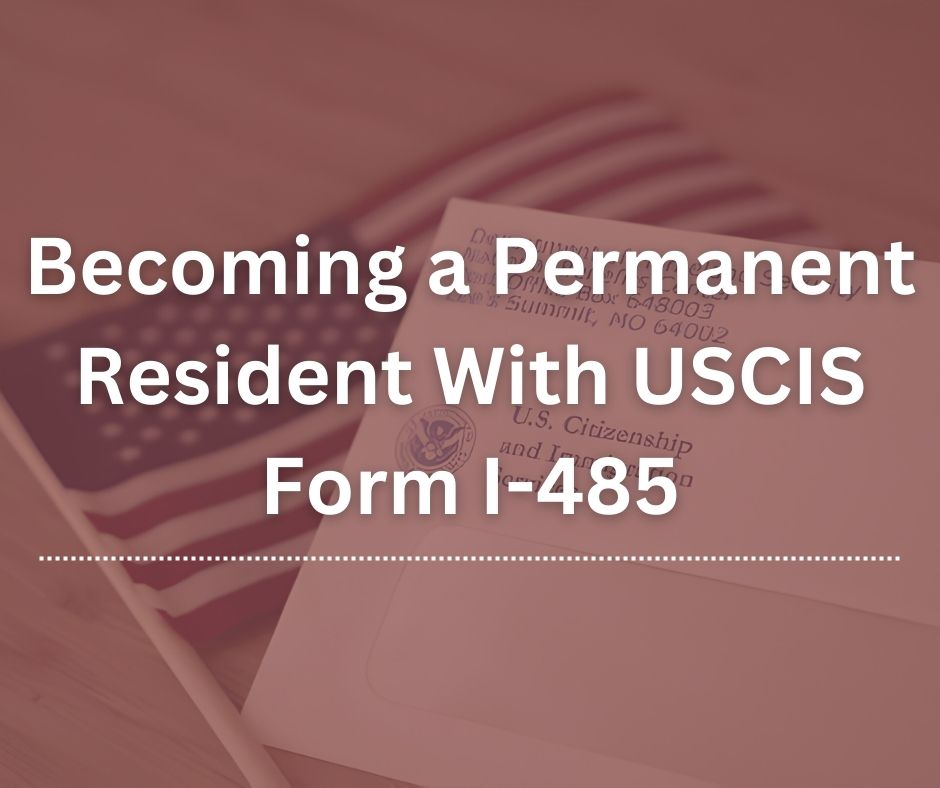
Applying for permanent residency, also known as getting a green card, is an exciting time in any intending immigrant’s life.
It means you are one step closer to being able to stay in the U.S. permanently.
If you are applying for a green card when already in the U.S., you may submit Form I-485 with another form or on its own.
Navigating the U.S. immigration system is a challenge, especially doing so alone. If you are an intending immigrant looking into how to obtain permanent residency, EMP Law can help. We fight to help everyday people, whether that means defending against a criminal accusation or navigating the maze-like complexity of U.S. immigration law.
Please fill out our online form or call (336) 724-2828 today to learn how our immigration lawyers can assist you.
What Is Form I-485 Used For?
Form I-485 allows individuals in the U.S. to apply for a Green Card by adjusting from temporary visa status to permanent residence without leaving the country. This form is required for most green card applications based on family, employment, asylum, or other eligibility categories.
What Is an Immigrant Visa?
Getting an immigrant visa is essentially synonymous with getting a green card. You can receive a green card if you are sponsored by a U.S. citizen or Lawful Permanent Resident (LPR), a U.S. employer, or, in some cases, yourself.
Immigrant visas are divided into several categories:
- Family-based,
- Employment-based,
- Humanitarian, and
- Diversity lottery.
When you file Form I-485, you apply for an immigrant visa. Before you file your I-485, you must already be the beneficiary of an approved petition with USCIS, have received asylum or refugee status, or have an immigrant visa immediately available. In short, the I-485 is never the first step in your green card process.
How Many Visas Are Issued Each Year?
To know when a visa will be available, you need to understand visa preference categories. Most family and employment-based visas are subject to yearly issuance caps.
Both are divided into “preference categories,” establishing priority for unused visas to be used for other categories. Unfortunately, the numerical limits have not been updated since their creation in 1952. As a result, instead of visas going unused, substantial backlogs have built up.
Family-Based Visas
Spouses, unmarried children under age 21, and parents of U.S. citizens are considered “immediate relatives” for visa purposes. Thankfully, immediate relatives are not subject to visa issuance caps.
All other family-based visa petitions are subject to yearly caps, divided as follows:
| Category | Sponsor | Beneficiary | Annual allotment |
| F1 | U.S. citizen | Unmarried children 21 and older | 23,400 |
| F2A | LPR | Spouses and unmarried children under age 21 | 87,900 |
| F2B | LPR | Unmarried children 21 and older | 26,266 |
| F3 | U.S. citizen | Married children | 23,400 |
| F4 | U.S. citizen | Siblings | 65,000 |
In addition to the worldwide limits, no individual country can account for more than 7% of the immigrant visas issued annually.
Employment-Based Visas
All employment visas are subject to caps, divided as follows:
| Category | Sponsor needed? | Beneficiary | Annual allotment |
| EB-1 | Sometimes | Extraordinary ability, outstanding researchers and professors, some multinational executives | 40,040 |
| EB-2 | Sometimes | Advanced degrees and exceptional ability | 40,040 |
| EB–3 | Yes | Skilled workers, professionals, and unskilled workers | 40,040 |
| EB-4 | Sometimes | “Special Immigrants” | 9,940 |
| EB-5 | No | Investors | 9,940 |
The same 7% country-based cap applies to employment-based visas.
What Must You Do Before You File Form I-485?
If you apply for a family-based visa, your sponsor must usually file Form I-130, Petition for Alien Relative, with USCIS before you file your I-485. If you are the spouse, child, or parent of a U.S. citizen or LPR who has abused you, you may be able to file on your own behalf using Form I-360, Petition for Amerasian, Widow(er), or Special Immigrant.
You also use Form I-360 to request employment-based EB-4 visas. Other employment-based visas often require your sponsor to get a labor certification from the U.S. Department of Labor before they start working with USCIS. Once they have labor certification, your sponsor submits Form I-140, Immigrant Petition for Alien Workers. If you are requesting an employment-based EB-5 investor visa, you submit Form I-526, Immigrant Petition by Standalone Investor, or Form I-526E, Immigrant Petition by Regional Center Investor.
If a visa is immediately available, you typically file the initial form—whether that is form I-130, I-140, I-360, I-526, or I-526E—together. Otherwise, you generally must wait for USCIS to resolve your first application. When USCIS approves one of these pre-I-485 forms, it declares that you qualify for the visa you are requesting. However, you must file an I-485 to request that USCIS issue the visa you are qualified to receive.
For other categories, you typically need to wait a number of years before you can submit your I-485. For example, you must hold asylum or refugee status for one year before you submit your I-485.
When Will an Immigrant Visa Be Available to Me?
Once you know your preference category, you can consult the visa bulletin to determine when a visa becomes available. Let’s use the January 2024 Visa Bulletin as an example. The bulletin is split between family and employment-based final action dates and dates for filing charts.
To read the charts, you need to know your priority date. Your priority date is when USCIS received your initial pre-I-485 application. Your priority date is printed on many notices from USCIS, beginning with your initial I-797 Notice of Action, which is titled Receipt Notice.
Final action dates represent visas issued by U.S. consulates abroad. The dates for filing chart tells applicants abroad when to begin submitting documents to the U.S. consulate to apply for a visa.
Your country of origin is also relevant, particularly if you are from China, India, Mexico, or the Philippines. Those countries are listed separately because they consistently exceed their 7% yearly allotment.
Since the charts are designed for people applying abroad, if you are filing Form I-485, you have one more step to complete. You have to consult USCIS to determine which of the charts to use. Once your priority date comes up or passes on the chart USCIS directs you to, an immigrant visa is available, and you can file your I-485.
What Do You File with Form I-485?
USCIS provides a handy I-485 checklist for what you need to provide when you apply, including:
- Government-issued identification,
- Two passport-style photos,
- A copy of your birth certificate,
- Proof of your immigration status and approved prior petition, and
- Details about your previous international travel.
Depending on your visa category, you may need to include additional documents.
Once you submit your I-485, USCIS will begin processing your application. You can check typical processing times to get a sense of how long processing might take.
EMP Law Can Help
If all of this sounds a little complicated, do not worry. At EMP Law, our experienced immigration lawyers can guide you through the process. We help you draft documents, provide information, complete applications, and manage your timelines. Contact us online or call (336) 724-2828 today to get started.



